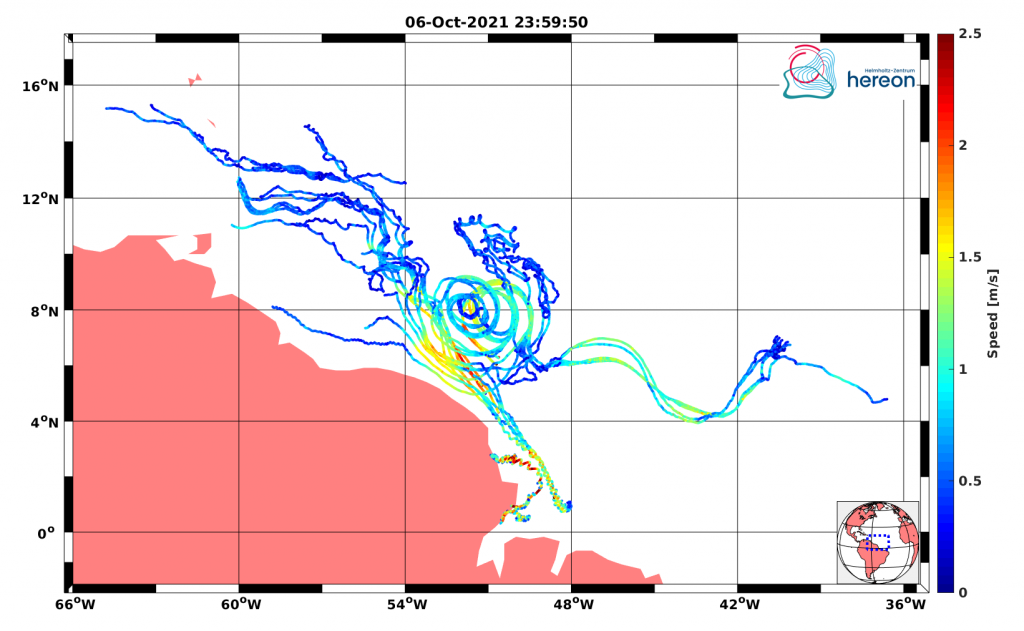Dublin, Ireland. 1 March, 2022 – Globalstar Europe Satellite Services Ltd, a wholly owned subsidiary of Globalstar Inc. , announces that German research institution The Helmholtz Center Hereon is using SPOT Trace satellite GPS trackers to conduct worldwide oceanography research.
Hereon has designed and engineered ocean drifter devices built around SPOT Trace which monitor ocean surface currents and reveal how biodiversity levels change in the world’s major rivers and seas. “Our purpose is to understand in greater detail the surface flow of water and organisms around the globe,” explains Dr. Jochen Horstmann, scientist at Hereon.
“We already have a reasonable idea of how currents work from satellite imagery and numerical models. However, we need reliable measurements of surface currents to better understand their processes and to improve our models,” he adds. The researchers use surface floats, or drifters, fitted with an underwater sail suspended at half a metre depth. These drifters report their position and therefore track the near-surface currents.
“As researchers, we always strive to get best possible value for money in the equipment we use, not only for us but for those governments, institutions and private individuals who fund our work.” he says. “We needed drifters that were economical, but when we looked at what devices were already available, these were typically very expensive, so we decided to build drifters ourselves,” he adds.

Horstmann and his colleagues knew they needed to build drifters capable of capturing and transmitting data even in extreme ocean conditions. “Our drifter needed to be robust enough to endure the elements, in particular severe wind conditions and waves,” explains Horstmann.
Position information is transmitted every five minutes via the Globalstar satellite fleet in Low-Earth Orbit (LEO). “By looking at the data transmitted by the SPOT Trace-equipped drifters, we can see where water and the organisms being carried flow and how biodiversity is affected,” he adds.
Hereon is also collaborating with the EU-funded Atlanteco project. Dr. Paulo Calil, a fellow scientist with Hereon, explains the Microbiomes experiment, which is the focus of Atlanteco.
“Over a billion microorganisms live in every litre of seawater, and thanks to plankton, the ocean absorbs 25% of the CO2 emitted by humans,” explains Dr. Calil. “But while an essential cog in the great climate machine, the functioning of this microbial world remains largely unknown,” he says.
“Our oceans are changing; they are becoming hotter on the surface because of climate change, and they are becoming more stratified,” Dr. Calil explains.
Changes in ocean currents affect transport and connectivity patterns. Hereon’s studies are helping researchers to understand how currents interact with plankton.
“There are widespread consequences of changes in currents for marine productivity, which in turn affects carbon levels and the whole ‘machinery’ of the ocean, as well as weather patterns,” he adds. Additionally, many areas can be impacted economically, such as for fisheries.
Hereon’s drifters have shown that the organisms travel extremely far, due to intensifying currents.
For example, in the South Atlantic, swirling eddies that form on the southern tip of Africa are seen to spread species all the way to eastern South America.
Compact rugged SPOT trace

SPOT Trace’s energy-efficient devices are playing a crucial role here, “Even after 150 days in the ocean, the drifters continue to send data, despite being subject to some rough conditions, waves and strong winds we’re delighted and really impressed with SPOT Trace,” comments Horstmann.
Physical oceanographers, microbiologists, biologists, geneticists, and biological oceanographers are all benefitting from this research.
“We are extremely proud that Globalstar technology is playing such a significant role in enhancing our understanding of the natural world, and how climate change is impacting our oceans and the biodiversity of life in them,” comments Mark O’Connell, general manager EMEA and APAC at Globalstar.
With its reliable tracking capabilities, robust physical properties including compact rugged design and long battery life, combined with its economical price, SPOT Trace has been widely embraced in the scientific community worldwide. Oceanographers across the globe are using SPOT Trace to gain a better understanding of the world’s seas, conduct oil spill research and monitor pollution.
Comment on this article below or via Twitter: @IoTNow_OR @jcIoTnow










